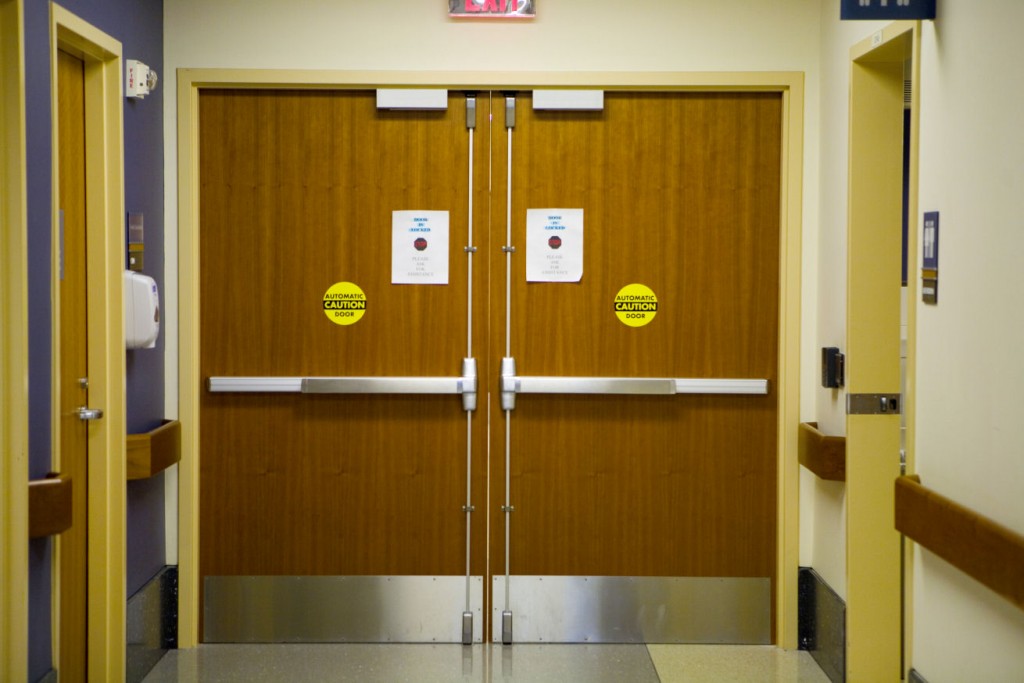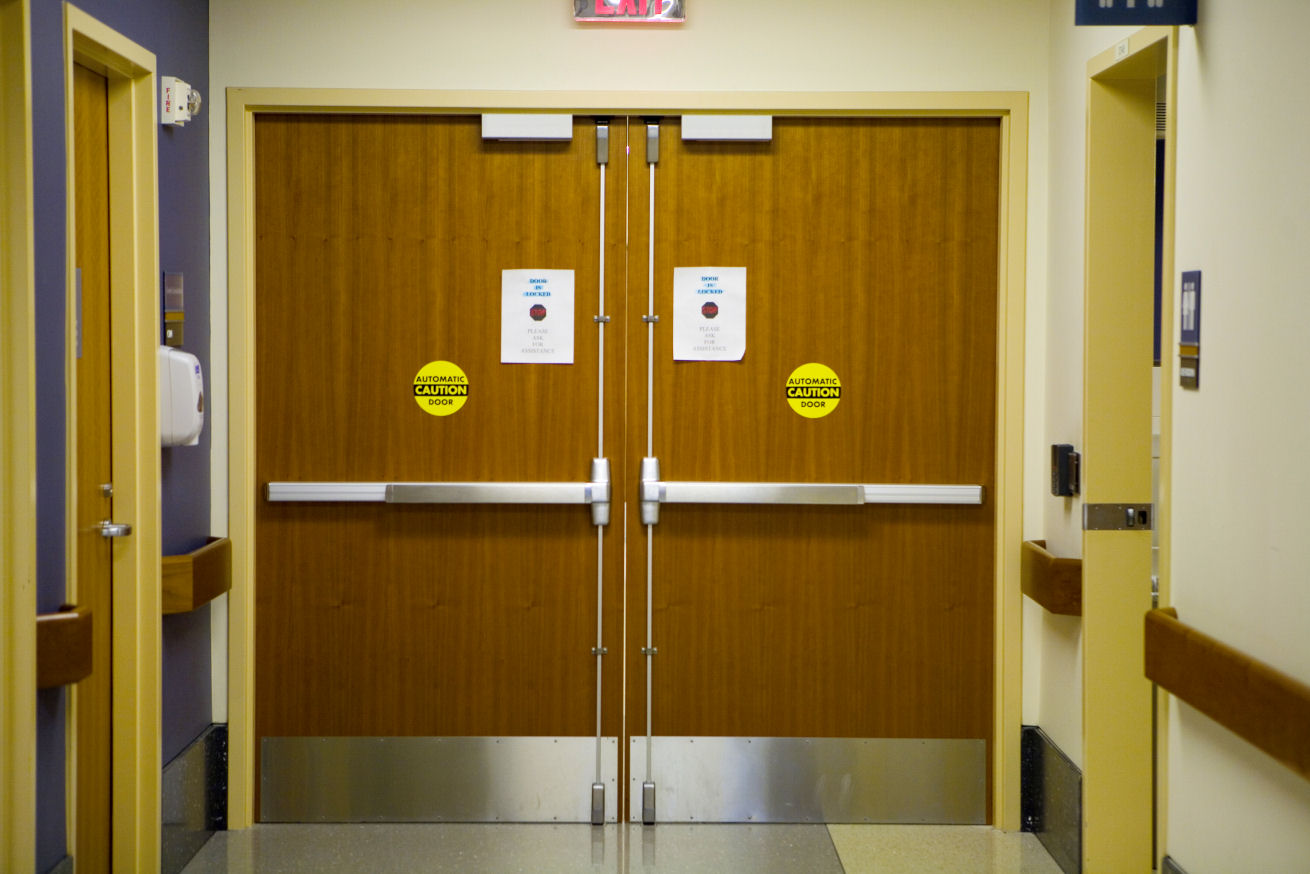This article was published in the October 2013 issue of the Locksmith Ledger:

The National Institute for Elopement Prevention and Resolution (www.elopement.org) defines elopement as:
“When a patient or resident who is cognitively, physically, mentally, emotionally, and/or chemically impaired; wanders away, walks away, runs away, escapes, or otherwise leaves a caregiving facility or environment unsupervised, unnoticed, and/or prior to their scheduled discharge.”
You might be asking yourself, “what’s a ‘special egress’ lock?” Maybe the term even inspired you to read this article. You won’t find a “special egress lock” in a manufacturer’s catalog, and searching online won’t help much either. The 2012 edition of the International Building Code (IBC) has been revised to include the phrase “special egress lock” and the fact that this term isn’t defined by our industry is actually a good thing. Read on.
As described by the International Building Code (IBC), an I-2 occupancy is a health care facility with 24-hour medical supervision for patients, with some or all of the occupants incapable of self-preservation and requiring assistance to reach safety in an emergency. Typically, hospitals, detox-facilities, nursing homes, and mental hospitals are considered I-2 occupancies.
These types of facilities often struggle with the balance between providing egress and protection from a fire, while also keeping their patients safe. “Elopement” is a term used to describe a nursing home or hospital patient leaving the unit or building on their own, which places them at risk of harm. Child and infant abduction is another concern when addressing the security of these facilities.
While psychiatric facilities have long been allowed some exceptions to the code requirements for free egress, many health care facilities have attempted to use a combination of code-compliant solutions, typically alarms and delayed egress locks, to prevent elopement and abduction. An alarm requires instantaneous response by staff, and a delayed egress lock only provides a 15-second egress delay (30 seconds with approval from the Authority Having Jurisdiction (AHJ)) to allow staff to investigate and respond. False alarms can exacerbate the problem. For many hospitals and nursing homes these products made it difficult to keep patients safe, which prompted some to use a waiver or variance process to request permission to secure certain egress doors. Without a consistent set of code requirements addressing these applications, it was up to the facility and AHJ to agree on an acceptable solution.
The 2009 edition of the IBC includes revised language which helps to address this issue, but also adds to the confusion. Section 1008.1.9.6, “Special Locking Arrangements in Group I-2” describes the requirements for locking I-2 occupancies when the clinical needs of the patients require such locking. According to the IBC Commentary, these patients may include those with dementia / Alzheimer’s disease (note that psychiatric facilities are exempt from some of the requirements). Along with other requirements for the facility, this section describes locks which:
- unlock upon actuation of the sprinkler system / fire detection system, and
- unlock upon loss of power to the lock, and
- are capable of being unlocked remotely, and
- must be able to be unlocked by clinical staff at all times.
To meet these requirements, a fail-safe electrified lock would be used, which will unlock when power is removed. But the 2009 IBC section includes the term “delayed egress lock”, even though the requirements are not describing the product known by that name. There is no requirement in this section for a 15-second delay initiating unlocking, special signage, or a local alarm. By using a term that is an established type of electronic security product, the code may be interpreted to mean that a delayed egress lock is required, but the requirements listed in the code clearly describe a fail-safe electrified lock, not a delayed egress lock.
A change was approved and included in the 2012 edition of the IBC which revises the language for this section. Instead of “delayed egress lock”, the term “special egress lock” is used, which eliminates some of the confusion by avoiding the use of defined product name. Because this is more of a clarification rather than an actual change, it can be used to help explain the intent of this section even though the 2012 edition may not be adopted in a project’s jurisdiction for several years. Additional refinements and clarifications have been proposed for the 2015 of the IBC.
In my opinion, either fail-safe electromechanical locks or electromagnetic locks would meet the intent of this section of the IBC, as long as all of the stated criteria are met and the clinical needs of the patients require such measures. Because the IBC does not specifically state which types of patient areas this applies to, that would need to be determined by the AHJ. If the door is fire-rated, it must have an active latch bolt to provide positive latching. For egress, it should take only one operation to unlatch the door after the lock has been released electronically.
Free egress is required by the IBC for these locations upon actuation of the fire alarm/sprinkler system, power failure, and remote release. The staff must be trained and ready to unlock the doors as needed, the building must be protected throughout with a sprinkler system / fire detection system, a building occupant must not pass through more than one door with a special egress lock before entering an exit, and emergency lighting must be provided at the door. Where patients require restraint or containment as part of the function of a psychiatric treatment area, some of the requirements for automated release of the doors do not apply. Refer to the code excerpt below for detailed information.
From the 2012 edition of the International Building Code (IBC):
1008.1.9.6 Special locking arrangements in Group I-2. Approved special egress locks shall be permitted in a Group I-2 occupancy where the clinical needs of persons receiving care require such locking. Special egress locks shall be permitted in such occupancies where the building is equipped throughout with an automatic sprinkler system in accordance with Section 903.3.1.1 or an approved automatic smoke or heat detection system installed in accordance with Section 907, provided that the doors are installed and operate in accordance with Items 1 through 7.
1. The doors unlock upon actuation of the automatic sprinkler system or automatic fire detection system.
2. The doors unlock upon loss of power controlling the lock or lock mechanism.
3. The door locks shall have the capability of being unlocked by a signal from the fire command center, a nursing station or other approved location.
4. A building occupant shall not be required to pass through more than one door equipped with a special egress lock before entering an exit.
5. The procedures for the operation(s) of the unlocking system shall be described and approved as part of the emergency planning and preparedness required by Chapter 4 of the International Fire Code.
6. All clinical staff shall have the keys, codes or other means necessary to operate the locking devices.
7. Emergency lighting shall be provided at the door.
Exception: Items 1 through 4 shall not apply to doors to areas where persons, which because of clinical needs, require restraint or containment as part of the function of a psychiatric treatment area.
The 2009 and 2012 editions of NFPA 101 – The Life Safety Code also contain language pertaining to locked doors in Health Care occupancies, although the requirements vary slightly from the IBC. Psychiatric units, Alzheimer units, and dementia units are referenced in Annex A as areas that may have locked doors which can be readily unlocked by staff. This applies to locations where the clinical needs of patients require specialized security measures or where patients pose a security threat. NFPA 101 requires these doors to be able to be unlocked by remote control of locks, or keys carried by staff at all times, or other reliable means available to staff. Only one lock is allowed per door.
Pediatric units, maternity units, and emergency departments are listed in Annex A as examples of areas where patient special needs require specialized protective measures for their safety. The building must be protected throughout by an approved, supervised automatic sprinkler system. Locked doors in these areas must be able to be readily unlocked by staff, have the capability of remote unlocking, and be automatically unlocked upon loss of power or actuation of the fire detection / sprinkler system. The locked space must be protected by a smoke detection system, or an approved constantly attended location within the locked space must be able to remotely unlock the doors. Complete requirements can be found in the NFPA 101 excerpt below:
From the 2012 edition of NFPA 101 – The Life Safety Code:
18.2.2.2.5.1* Door-locking arrangements shall be permitted where the clinical needs of patients require specialized security measures or where patients pose a security threat, provided that staff can readily unlock doors at all times in accordance with 18.2.2.2.6.
18.2.2.2.5.2 Door-locking arrangements shall be permitted where patient special needs require specialized protective measures for their safety, provided that all of the following criteria are met:
(1) Staff can readily unlock doors at all times in accordance with 18.2.2.2.6.
(2) A total (complete) smoke detection system is provided throughout the locked space in accordance with 9.6.2.9, or locked doors can be remotely unlocked at an approved, constantly attended location within the locked space.
(3)*The building is protected throughout by an approved, supervised automatic sprinkler system in accordance with 18.3.5.1.
(4) The locks are electrical locks that fail safely so as to release upon loss of power to the device.
(5) The locks release by independent activation of each of the following:
..(a) Activation of the smoke detection system required by 18.2.2.2.5.2(2)
..(b) Waterflow in the automatic sprinkler system required by 18.2.2.2.5.2(3)
18.2.2.2.6 Doors that are located in the means of egress and are permitted to be locked under other provisions of 18.2.2.2.5 shall comply with the following:
(1) Provisions shall be made for the rapid removal of occupants by means of one of the following:
…(a) Remote control of locks
…(b) Keying of all locks to keys carried by staff at all times
…(c) Other such reliable means available to the staff at all times
(2) Only one locking device shall be permitted on each door.
From Annex A:
A.18.2.2.2.5.1 Psychiatric units, Alzheimer units, and dementia units are examples of areas with patients who might have clinical needs that justify door locking. Forensic units and detention units are examples of areas with patients who might pose a security threat. Where Alzheimer or dementia patients in nursing homes are not housed in specialized units, the provisions of 18.2.2.2.5.1 should not apply. (See 18.2.2.2.5.2.)
A.18.2.2.2.5.2 Pediatric units, maternity units, and emergency departments are examples of areas where patients might have special needs that justify door locking.
These new requirements apply to buildings and facilities where the referenced editions of these codes have been adopted. For locations where other codes are used, or where funding or accreditation organizations reference another version of the code, facilities may be required to apply for an equivalency, a waiver, or a variance in order to install locks allowed by the more recent codes. Consult the local requirements and the Authority Having Jurisdiction to determine the specifics for the facility in question.
You need to login or register to bookmark/favorite this content.






A question related to IBC item 4. “A building occupant shall not be required to pass through more than one door equipped with a special egress lock before entering an exit.”
I have done designs where there were in fact two delayed egress doors in the path of egress (in this case your 99 Chexits); but the exterior door was slaved to the interior door. In other words, the second door you went though was (because the first door disabled the delay) in fact was not considered a “special egress device”. To my knowledge this arrangement is still functioning as designed in 2004, passed many inspections. At final inspection, the fire marshall wanted to see it work which of course it did. Bolstered by this, I attempted to do it other places, and no dice in some; ok in others, but always noted.
So what is your opinion?
Hi Jim –
The special egress/controlled egress code requirements for this article are covered in a different section than delayed egress, but the delayed egress section has a similar limitation. Section 1010.1.9.7 of the 2015 IBC (Delayed Egress) says: “The egress path from any point shall not pass through more than one delayed egress locking system. Exception: In Group I-2 or I-3 occupancies, the egress path from any point in the building shall pass through not more than two delayed egress locking systems provided the combined delay does not exceed 30 seconds.” (the exception is new)
I have had a few situations over the years where I had 2 delayed egress locks in an egress path and I wired them together as you described. I have not had an AHJ cite them as a problem, but the code leaves a little bit to interpretation. It says that the path can’t pass through more than one delayed egress locking system (or 2 for I-2 and I-3), so an AHJ could say that the path is still passing through more than one system even though the second one has already released. It depends on if they’re interpreting it literally or looking at the intent of the codes. In my experience, the more familiar the AHJ is with electric locking systems, the more willing they are to look at the intent and the function.
– Lori
Hi Lori,
I am not a hardware specialist, just a caregiver whose mother has moved to an assisted living facility, one which specializes in Memory care. While she began her stay there in the Dayspring, or minimally impaired wing, where residents came and went fairly freely, she soon needed a special wrist sensor to alert the staff if she exited the building. She continued her “elopement” attempts and we moved her into the most secure area, with limited access and higher staffing levels… She is still attempting exits, most recently through a “delayed exit” door – her facility has them timed at 15 seconds, though another franchise in town has theirs set for 30 seconds. The loud alarm does not seem to deter her. Researching brought me to your site and I have learned quite a bit regarding codes and interpretation. I too had the idea even before beginning this research that her wrist sensor could just as easily Lock one of those doors, barring smoke alarms going off, or in lieu of that, signal a staffed station with cameras and sensor/lock control that she was lingering nearby, and allow the staffer to override the alarm as well as the lock – no alarm, no exit, again barring any emergency situations. She could try the door, find it locked, and move on down the hall without waking other residents or scrambling the staff who might be otherwise engaged in more serious duties. Given this “elopement” seems to be fairly common in people in my mothers situation, I am surprised not to see anyone using such a system. Your thoughts would be appreciated!
Hi Mark –
Thank you for sharing the experience you have had with your mother. Her attempts to exit the building are not uncommon among residents of memory care facilities, which is why the model codes were changed in 2009 to give facilities another option. Having the lock tied in with your mother’s sensor is one option – whether the sensor causes the door to lock or sends a signal to a staffed station. This would be a good solution if there are some residents who are allowed to come and go freely, and some who are not. If the unit where your mother lives is occupied by residents who are not permitted to leave on their own, the controlled egress section of the model codes allows the doors to be locked indefinitely – not just when the sensor is nearby.
The first step would be for you to talk to the director of facilities to see if they are willing to look at another option. The second step would be to confirm which edition of which code the facility is required to comply with, to make sure that controlled egress is allowed in the jurisdiction where the project is located. If the facility manager is interested in talking to someone about controlled egress locks, I can send you the contact information for the Allegion representative in your area.
Please let me know if there are any questions that I can help with.
– Lori